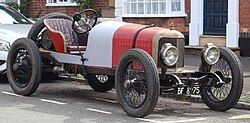
LaSalle was an American brand of luxury automobiles manufactured and marketed, as a separate brand, by General Motors' Cadillac division from 1927 through 1940. Alfred P. Sloan, GM's Chairman of the Board, developed the concept for four new GM marques - LaSalle, Marquette, Viking and Pontiac - paired with already established brands to fill price gaps he perceived in the General Motors product portfolio. Sloan created LaSalle as a companion marque for Cadillac. LaSalle automobiles were manufactured by Cadillac, but were priced lower than Cadillac-branded automobiles, were shorter, and were marketed as the second-most prestigious marque in the General Motors portfolio. LaSalles were titled as LaSalles, and not as Cadillacs. Like Cadillac — named after Antoine de la Mothe Cadillac — the LaSalle brand name was based on that of another French explorer, René-Robert Cavelier, Sieur de La Salle.

The Chrysler Imperial, introduced in 1926, was Chrysler's top-of-the-line vehicle for much of its history. Models were produced with the Chrysler name until 1954, after which it became a standalone brand; and again from 1990 to 1993. The company positioned the cars as a prestige marque to rival Cadillac, Continental, Lincoln, Duesenberg, Pierce Arrow, Cord, and Packard. According to Antique Automobile, "The adjective 'imperial' according to Webster's Dictionary means sovereign, supreme, superior or of unusual size or excellence. The word imperial thus justly befits Chrysler's highest priced model."
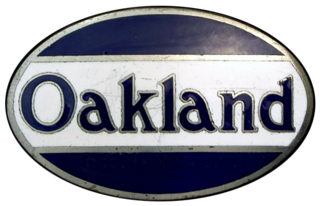
The Oakland Motor Car Company of Pontiac, Michigan, was an American automobile manufacturer and division of General Motors. Purchased by General Motors in 1909, the company continued to produce modestly priced automobiles until 1931 when the brand was dropped in favor of the division's Pontiac make.

The Cadillac V8, introduced as the Type 51, is a large, luxurious automobile that was introduced in September 1914 by Cadillac as a 1915 model. It was Cadillac's first V8 automobile, replacing the four-cylinder Model 30, and used the all new GM A platform for the entire series shared with all GM division brands using a 122 in (3,099 mm) wheelbase, while a 145 in (3,683 mm) chassis was offered separately to be used for custom coachwork. The Types 53, 55, 57, 59, and 61 were introduced every year through 1923 with yearly improvements until an all new platform was substantially updated and introduced as the V-63 using the business philosophy called planned obsolescence. It was built at the Cass Street and Amsterdam Avenue factory in Detroit, with the coachwork provided by Fisher Body. The chassis could be purchased separately and sent to the clients choice of coachbuilder optionally.

The Cadillac V-63 is a large luxury automobile that was introduced in September 1923 by Cadillac as a 1924 model, replacing the previous Type 61. It used the GM C platform and was replaced by the Cadillac Series 355 in 1931. It retained the name Cadillac V8 introduced with the previous generation Cadillac Type 51.

Marquette was an American automobile manufacturer established by General Motors in 1909 after the purchase of the Rainier Motor Car Company. The Marquette Company did not last long and in 1912 GM announced the company would be closed.
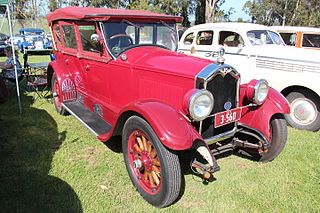
The Buick Standard Six Series 20 was manufactured by Buick at what would later become known as the Buick City factory on Hamilton Ave. in Flint, Michigan, and was the junior model to the Buick Master Six between 1925 through 1929, and shared the GM A platform with Oldsmobile, Oakland and Chevrolet. The Standard Six evolved from the earlier Buick Six when the Buick 4-cylinder was cancelled. The Standard Six was the most popular Buick sold while being more upscale to the Oldsmobile Six. It was the senior brand to Marquette under the General Motors Companion Make Program until Marquette was cancelled one year later. It replaced the earlier Buick Six that was introduced in 1916, and was replaced with the Buick Series 50. Coachwork continued to be offered by Fisher Body who was the primary supplier of all GM products at this time, and Duco automotive lacquer paint, introduced by DuPont was the first quick drying multi-color line of nitrocellulose lacquers made especially for the automotive industry.
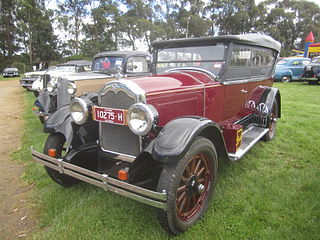
The Buick Master Six, also denoted Series 40 and Series 50 based on the wheelbase used, was an automobile built by Buick from 1925 to 1928 and shared the GM B platform with the Oldsmobile Model 30. Previously, the company manufactured the Buick Six that used the overhead valve six-cylinder 242 cu in (4.0 L) engine in their high-end cars, and the Buick Four for smaller, less-expensive cars. After 1924, they dropped the four-cylinder engine and designed a small six, which they called the Buick Standard Six, to replace that end of the market. They coined the name "Master Six" for the high-end cars, now powered by the 255 cu in (4.2 L) engine released the year before. The yearly changes were a result of a new business philosophy called planned obsolescence
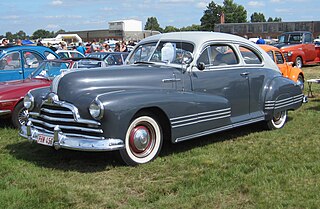
The Pontiac Streamliner is a full-size car produced under the Pontiac brand by General Motors from 1932 until 1952. A mass-produced and popular vehicle, it was a significant luxury car during the recovery from the Great Depression, and during and immediately after the Second World War.

The Chevrolet Series AB National is an American vehicle manufactured by Chevrolet in 1928 to replace the 1927 Series AA Capitol. Documented production numbers show that 1,193,212 Series ABs were manufactured in a variety of body styles with 69,217 originating from the Oshawa factory alone. Chevrolet instituted serial number recorded on the front seat heel board on either the left or right side, using the listed numbers to designate the point of origin of the vehicle identified.

The Buick 4 was a series of passenger cars produced by the Buick Division of GM from 1909 through 1918, and was available as a touring car, phaeton or roadster. It was available with the Buick Model B as a larger alternative offering a larger engine and better durability. It became the junior sedan in 1914 when the Buick Six was introduced.

The Oldsmobile Model 30, which continued to be known as the Oldsmobile Six, was built from the 1923 through 1927. Each year it was built, it was given the suffix 30-A, 30-B, 30-C, 30-D and 30-E for the last year of production, all having been manufactured in Lansing, Michigan. General Motors used the GM A platform, shared with the Buick Standard Six and the Oakland Six, and the yearly changes were the result of a new business philosophy called planned obsolescence. The Model 30 was Oldsmobile mid-level product and introduced the flathead Oldsmobile straight-6 engine, while the Oldsmobile Model 43 with a four-cylinder engine remained the entry level product. When the top level Oldsmobile Light Eight, with the flathead Oldsmobile V8 engine was cancelled in 1923, the Oldsmobile Six became the top level vehicle. It replaced the Oldsmobile Model 37 introduced in 1917, and was replaced by the Oldsmobile F-Series introduced in 1928. In 5 years, 236,474 cars were built. The growing popularity of GM's brands, like Oldsmobile, contributed to becoming the largest automobile manufacturer when sales overtook the Ford Motor Company during this time period. Coachwork for the various bodystyles were supplied by Fisher Body of Detroit, MI, and starting with the 1923 model year, all GM products adopted a shared appearance, with brand specific unique appearance features. The retail price had dropped considerably from previous years due to the popularity and affordability of the Ford Model T, with the top level sedan at US$1,095.
The Model 42 was an entry-level four seat passenger car produced by GM's Oldsmobile Division in 1914. It was offered as a replacement to the Oldsmobile Curved Dash runabout when it was discontinued in 1908, and was the junior platform to the Oldsmobile Six introduced in 1913. GM had acquired Elmore Manufacturing Company, Oldsmobile and Oakland Motor Car Company in 1908 and Cartercar and Rainier Motor Car Company in 1909 as their entry-level models, and Oldsmobile products were being repositioned in their new hierarchy as GM began to consolidate operations after William Durant had left.
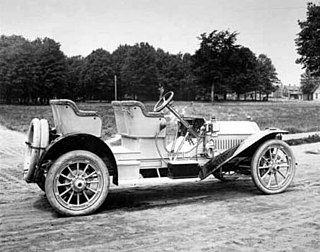
The Model M was a four-seat passenger car produced by Oldsmobile in 1908, offered as a mid-range alternative to the Model R Curved Dash runabout that appeared in 1901, replacing the Model A. It was the junior sedan to the first six-cylinder sedan called the Oldsmobile Model Z also introduced in 1908, but was larger than the Oldsmobile Model X.

The Oldsmobile Six, also known as the Model 53, 54 and 55 (1913-1915) then a brief cancellation until it reappeared as the Model 37, 37A and 37B (1917-1921) was a top level sedan along with the Oldsmobile Series 40 junior vehicle produced by GM's Oldsmobile Division and was manufactured at Lansing Car Assembly in Lansing, Michigan. It replaced the Series 28 also known as the "Oldsmobile Autocrat" and was replaced by the Oldsmobile Model 30 in 1927, and shared wheelbases with the Buick Six. It continued to use the T-head engine for two years. The various bodystyles were supplied by Fisher Body of Detroit, MI. It competed with the Chevrolet Series C Classic Six as Chevrolet was an independent company before becoming a division in 1917. Oldsmobile also shared technology with GMC for commercial and industrial products.
The Oldsmobile Series 28, also known as the Autocrat, was a mid-level four seat passenger car produced by GM's Oldsmobile Division for 1911 and 1912. It was based on the top-level Oldsmobile Limited while using a four-cylinder engine, and was manufactured in Lansing, Michigan.

The Oldsmobile F-Series was a pre-WWII passenger car built from the 1928 through 1938 model years. The first generation continued the tradition of adding a series number for each model year; F-28, F-29, F-30 and F-31. The second generation, signified by a completely new bodystyle appearance was built from 1932 through 1938, all having been manufactured in Lansing, Michigan. 1926 saw the introduction of GM's most recognized business model, the use of common platforms shared amongst the brands, and Oldsmobile and Buick shared the GM B platform. The F-Series was shared with the Buick Master Six and was also known as the Oldsmobile Six which was introduced as a name earlier in 1913.

The Oldsmobile Light Eight was an automobile produced by the Oldsmobile Division of General Motors in roadster, two-door coupe, four-door sedan from between 1916 and 1923. It was powered by a sidevalve V8 engine, the maker's first, and shared with the 1916 Oakland Model 50.

The Oakland Six was the first six-cylinder engine offered by the Oakland Motor Company in 1913 which became a division of General Motors in 1909. The Oakland Six was offered in many different model names that changed every year, along with several body styles and engine displacements until 1929, when the V8 was reintroduced, then in 1931 Oakland was renamed Pontiac. When Oakland became a division of GM and introduced the Oakland Four, Oldsmobile and Buick shared bodywork and chassis of their six-cylinder models with Oakland. When Chevrolet became part of GM in 1917, Oakland chassis and bodywork were shared with Chevrolet. Manufacture of the Oakland was completed in Pontiac, Michigan.

The Pontiac 6 was a more affordable version of its predecessor Oakland Six that was introduced in 1926, sold through Oakland Dealerships. Pontiac was the first of General Motors companion make program where brands were introduced to fill in pricing gaps that had developed between Cadillac, Buick, Oldsmobile, Oakland and Chevrolet. The original marketing approach began when GM was incorporated in 1908 was to offer a range of vehicles in various body styles based on affordable to extravagant, and the customer base would gradually trade up every few years to the next hierarchy brand. Pontiac was introduced as an affordable Oakland, followed by LaSalle for Cadillac, Marquette for Buick and Viking for Oldsmobile. Pontiac's introduction was a sales success while customers shied away from the more expensive Oakland, and once the Wall Street Crash of 1929 and the Great Depression followed, both Pontiac and Oakland were being considered for cancellation but the decision was made to keep Pontiac as the economy began to recover.



